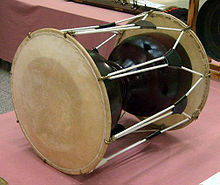Janggu
| Janggu | |
 |
|
| Korean name | |
|---|---|
| Hangul | 장고 or 장구 |
| Hanja | |
| Revised Romanization | janggo or janggu |
| McCune–Reischauer | changgo or changgu |
The janggu (or janggo; also spelled changgo) or sometimes called seyogo (slim waist drum) is the most representative drum in traditional Korean music.. It is available in most kinds, and consists of an hourglass-shaped body with two heads made from animal skin. The two heads produce sounds of different pitch and timbre, which when played together are believed to represent the harmony of man and woman.
The first depiction of the instrument is on a bell belonging to the Silla (57 BC–935 AD) period and in a mural painting of the same period in Goguryeo (37 BC–935 AD) tomb. The oldest Korean historical records about an hourglass-shaped drum may be traced to the reign of King Munjong (1047–1084) of Goryeo as a field instrument. The Goryeo-sa (1451), or History of Goryeo, in chapter 70, records twenty janggu as part of a gift of instruments to be used in royal banquet music from the Song Dynasty Emperor Huizong to the Goryeo Court in Gaeseong in 1114. This book represents the earliest appearance of the word janggu in a Korean source. Later in chapter 80, for the year 1076, the term janggu-opsa (one who plays or teaches the janggu) is used.
The janggu may have evolved from the yogo (Hangul: 요고; Hanja: 腰鼓; literally "waist drum"), another similar but smaller Korean drum that is still in use today. The yogo is thought to have originated from the idakka, an Indian instrument introduced into Korea from India through China during the Silla (57 BC–935 AD) period. Evidence of the yogo was depicted on the mural paintings in the tomb of Jipanhyun of Goguryeo, and from the pictures at the Gameun Temple, the Relics of Buddha, made of bronze in the second year of King Mun (682) during the Unified Silla period. It was during the time of Goryeo that the size of the Janggu grew to its present-day standard.
...
Wikipedia
